Presentation to Judiciary and Senate Committees on Maryland Child Support Guidelines
Introduction, purpose, committee members, quick history of Maryland guidelines, income shares model, and 2016 quadrennial review presented to the House Judiciary Committee and Senate Judicial Proceedings Committee to discuss current issues, proposed solutions, and legislative considerations regarding Maryland Child Support Guidelines.
Download Presentation

Please find below an Image/Link to download the presentation.
The content on the website is provided AS IS for your information and personal use only. It may not be sold, licensed, or shared on other websites without obtaining consent from the author. Download presentation by click this link. If you encounter any issues during the download, it is possible that the publisher has removed the file from their server.
E N D
Presentation Transcript
Presentation to the House Judiciary Committee and the Senate Judicial Proceedings Committee Friday, January 18, 2019 1
Introduction & Purpose Maryland Child Support Guidelines Child Support Guidelines Advisory Committee Discussion of current issues and concerns Proposed solutions for legislative consideration 2
Committee Members Maryland General Assembly Delegate Kathleen M. Dumais Delegate Michael E. Malone Senator William C. Smith Jr. University of Maryland, School of Social Work Letitia Logan Passarella, MPP, Research Director Center for Policy Research Jane Venohr, Ph. D Judiciary Administrative Office of the Courts-Programs Jennifer Williams, Magistrate Title IV-D Attorneys Karen Hess Rohrbaugh, Esq. Charlton T. Howard, Esq. Mark A. Tyler, Esq. Keri Kelly, Esq. Honorable Cynthia Callahan Hope Gary, Department of Juvenile & Family Services, Private Attorneys James D. Milko, Esq. Laure Ruth, Esq. Mary Sanders, Esq. Maryland Child Support Administration Kim Hale, Carroll County Jessica Roebuck, Carroll County Mia Pinkney, Prince George s County Stephen Holmes, Policy Research Analyst Maria L. Oesterreicher, Esq., Division Director, Program Development Jarnice Johnson, Deputy Executive Director of Programs Kevin P. Guistwite, Executive Director Family and Workforce Non-Profits Joseph T. Jones, Center for Urban Families Dorothy Lennig, Esq., Marjorie Cook Foundation Domestic Violence Legal Clinic House of Ruth Sara Muempfer, Annie E. Casey Foundation Melanie Shapiro, Esq., Maryland Office of Public Defender Melanie Styles, The Abell Foundation Nikki Thompson, Job Opportunities Task Force Regan Vaughan, Catholic Charities Caryn York, Job Opportunities Task Force 3
Quick History of Maryland Guidelines 1989 2007 Adoption of guidelines with self- support reserve Health insurance revised to additional cost 2010 2004 Guidelines schedule updated Self-support reserve updated 4
Income Shares Model Custodial Parent Noncustodial Parent Considers income of both parents Gross Income $500 $1,500 Total Combined Income $2,000 Prorated obligation Percentage of Total Income 25% 75% Perceived to be fair Cost of Raising 1 Child $395 Parent s Responsibility/Obli gation $296.25 $98.75 Used by 39 states 5
2016 Quadrennial Review Two reports submitted to the General Assembly: Maryland Child Support Guidelines: 2011-2014 Case-Level Review Letitia Logan Passarella, MPP, Research Director, University of Maryland School of Social Work. 1. Economic Review of the Maryland Child Support Guidelines Schedule Jane Venohr, Ph.D., Center for Policy Research. 2. Recommend giving courts more guidance on determining support order amounts for parents whose incomes fall below the guidelines schedule. 6
Child Support Guidelines Advisory Committee Mission: Review the guidelines in light of the best interests of Maryland s children and families. Goal 1: Ensure that Maryland s child support guidelines are economically accurate and reflect the most recent available economic data. Goal 2: Ensure that the application of the guidelines results in the optimal outcome for Maryland s children and families. 7
Low-Income Subcommittee Unemployed at order establishment EARNINGSUSEDFORDETERMININGTHEORDER Employed at order establishment $27,996 $15,084 ACTUAL WAGES Based on employment in MD $27,542 $6,152 Unrealistic orders Low payment compliance Large past-due balances Drivers license suspension Wage garnishment up to 65% ANNUAL SUPPORT DUE $4,800 $2,588 COLLECTIONS 31% $975 67% $3,239 8 Note: Data is based on the 2011-2014 Case-Level Guidelines Review
Low-Income Subcommittee cont. Not defined in family law. Recognized in case law. Voluntarily Impoverished Recommend to define in Family Law 12-201 Promote transparency Limit improper determinations Not aligned with the recent federal rule1 Potential Income Recommend to update in Family Law 12-201 Incorporate House Bill 386 from 2018 Legislative Session 1 Flexibility, Efficiency, and Modernization in Child Support Enforcement Programs Rule effective January 19, 2017 (see Title 45 of the Code of Federal Regulations 302.56) 9
Low-Income Subcommittee cont. No Support Order Establishment Recent federal rule1 allows a case to close if the obligor is: Recommend a provision in Family Law 12-202 allowing courts to decline to establish or to modify a support order in these circumstances. living with the minor child, incarcerated or institutionalized in a psychiatric care facility for the minority of the child s life, medically-verified to have a total and permanent disability, or obligor s sole income is SSI or SSDI. 1 Flexibility, Efficiency, and Modernization in Child Support Enforcement Programs Rule effective January 19, 2017 (see Title 45 of the Code of Federal Regulations 303.11) 10
Low-Income Subcommittee cont. Combined Parental Incomes below $1,250 Current Guidelines Recommendations Guidelines recommend a discretionary order amount between $20 and $150. List specific schedule amounts at the low end. Include $0 in the lowest income bracket. Case-level review found 40% of order amounts were above $150. Begin the minimum obligation for one child at $50. One in three orders were $162 or $163. Increase the minimum obligation by the proportional cost of raising additional children. More guidance is needed. 11
Low-Income Subcommittee cont. Specify Order Amounts at Low Incomes Current Guidelines Schedule Combined Adj. Actual Income 1 Child 2 Children 3 Children 4 Children 5 Children 6 Children $20 - $150 Per Month, Based on Resources And Living Expenses of Obligor and Number of Children Due Support 100-1200 1250 162 163 165 167 169 170 Proposed New Guidelines Schedule Combined Adj. Actual Income 1 Child 50 56 91 126 2 Children 55 60 98 135 3 Children 4 Children 58 63 101 140 5 Children 59 64 103 142 6 Children 60 65 104 144 57 62 100 139 0-1100 1150 1200 1250 12
Low-Income Subcommittee cont. Self-Support Reserve (SSR) Current SSR Recommendations SSR is intended to leave the obligor with a minimum income after payment of: Based on the 2008 Federal Poverty Level for one person, $867 per month. Update the SSR. Define the SSR in Family Law 12- 201. Include shading in the schedule to indicate the SSR adjustment. Child Support, Built into the guidelines schedule. Invisible to parents. Fully effective when only the obligor has income. Federal & State Income Taxes, and Include a deviation provision if an obligor s income falls below the SSR. FICA. 13
Low-Income Subcommittee cont. Current and New Schedule With SSR Shaded Current Schedule Proposed Schedule Combined Adj. Combined Ad. Actual Income 6 or More Children Actual Income 6 or More Children 1 Child 2 Children 3 Children 4 Children 5 Children 1 Child 2 Children 3 Children 4 Children 5 Children 0- $20 - $150 Per Month, Based On Resources And Living Expenses Of Obligor And Number Of Children 50 55 57 58 59 60 1100 100-1200 1150 56 60 62 63 64 65 1250 162 163 165 167 169 170 1200 91 98 100 101 103 104 1300 195 197 199 202 204 206 1250 126 135 139 140 142 144 1350 229 231 234 236 239 241 1300 161 173 177 179 182 184 1400 262 265 268 271 274 277 1350 196 210 216 218 221 224 1450 295 299 302 305 308 312 1400 231 248 254 257 261 264 1500 310 330 334 338 341 345 1450 266 285 293 296 300 304 1550 319 362 366 370 374 378 1500 301 323 331 335 340 344 1600 327 394 398 402 407 411 1550 320 360 370 374 379 384 1650 336 425 430 435 439 444 1600 330 398 408 413 419 424 1650 339 435 447 452 458 464 1700 344 457 462 467 472 477 1700 348 473 485 491 498 504 1750 353 488 494 499 505 510 1750 357 510 524 530 537 544 1800 361 520 526 532 537 543 1800 367 538 562 569 577 584 1850 370 537 558 564 570 576 1850 376 551 601 608 616 624 1900 378 550 590 596 603 609 1900 385 565 639 647 656 664 1950 387 562 622 629 635 642 1950 394 578 678 686 695 704 2000 395 575 654 661 668 675 2000 403 591 714 725 735 744 2050 403 585 686 693 701 708 2050 412 604 730 764 774 784 2100 412 598 706 726 733 741 2100 421 617 746 803 814 824 2150 420 610 720 758 766 774 2150 430 631 762 842 853 864 2200 428 622 734 790 799 807 2200 439 644 778 869 893 904 2250 437 634 748 823 831 840 2250 448 657 794 887 932 944 2300 445 646 761 851 864 873 2300 457 670 810 905 972 984 2350 453 657 775 866 897 906 2350 466 684 826 923 1011 1024 2400 462 669 789 882 930 939 2400 475 697 842 941 1035 1064 2450 470 681 803 897 962 972 2450 484 710 858 958 1054 1104 2500 478 693 817 913 995 1005 2500 493 723 874 976 1074 1144 2550 486 705 831 928 1021 1039 2550 502 736 890 994 1094 1184 2600 495 717 845 944 1038 1072 2600 511 750 906 1012 1113 1210 2650 503 729 859 959 1055 1105 2650 520 763 922 1030 1133 1231 2700 511 741 873 975 1072 1138 2700 529 776 938 1048 1152 1253 14
High-Income Subcommittee History of Child Support Schedule When originally enacted in 1989, the Maryland Child Support Guidelines schedule ended at combined actual adjusted incomes of $10,000 per month In 2010, the Guidelines schedule was adjusted by the Legislature. This adjustment included extending the Guidelines schedule to include cases involving combined actual adjusted incomes of up to $15,000 per month This has been the only expansion of the Guidelines Schedule regarding combined actual adjusted incomes in the past 30 years 15
High-Income Subcommittee cont. A Real-world example: Parties reside in Maryland and have 3 minor children. Wife is a computer software programmer at a small, private firm in Montgomery County and has a salary of $129,000. Husband is a Special Education Instructor for the Prince George s County Public School System and has a salary of $72,000. The parties separate. This case would fall outside of the existing Guidelines schedule. 16
High-Income Subcommittee cont. Result: Family Law Article 12-204(d) Judicial Discretion If the combined adjusted actual income exceeds the highest level specified in the schedule in subsection (e) of this section [the Schedule], the court may use its discretion in setting the amount of child support. 17
High-Income Subcommittee cont. This discretion is typically employed in two ways: Detailed testimony and evidence regarding the needs of the children, and the adjudication of child support on a case-by-case basis; or 1. Extrapolation of the existing Guidelines Support schedule through utilization of the SASI support calculation program 2. 18
High-Income Subcommittee cont. Drawbacks to this approach: Case-by-Case Adjudication Extrapolation of Guidelines Results in scenarios in which similarly situated children/families receive significantly disparate child support outcomes Extrapolation of the Guidelines using existing support calculation computer programs results in support awards that are not based upon current economic data Issues of judicial economy and litigation expense 19
High-Income Subcommittee cont. A Practical Solution: Expand the current Guidelines Schedule from $15,000 to $30,000 Base the expanded schedule on actual, current economic data (as opposed to mere mathematical extrapolation) Promote uniformity of child support outcomes for families within the combined actual adjusted income range of $15,000 to $30,000 Continue to allow judicial discretion in cases involving significant wealth (i.e.- cases above $30,000) 20
High-Income Subcommittee cont. Extend Guidelines from $15,000 to $30,000 Combined Adjusted Actual Income 1 Child 2 Children 14700 1903 2790 14750 1910 2800 14800 1916 2809 14850 1923 2819 14900 1929 2828 14950 1936 2838 15000 1942 2847 . . . 29700 3143 4564 29750 3147 4570 29800 3150 4575 5232 5844 6428 6988 29850 3153 4580 29900 3157 4586 29950 3160 4591 30000 3163 4596 3 Children 4 Children 5 Children 6 or More Children 3312 3323 3334 3345 3357 3368 3379 3708 3721 3734 3746 3759 3772 3784 4102 4130 4144 4158 4172 4186 4477 4493 4508 4523 4538 4554 4569 4116 5220 5226 5831 5837 6414 6421 6972 6980 5238 5244 5259 5256 5851 6436 5857 5864 5871 6996 7004 7012 7020 6443 6451 6458 21
Cliff Effect Subcommittee Cliff Effect refers to the precipitous drop in the calculated child support obligation when shared physical custody by the support obligor reaches 35% of the overnights in a calendar year. $600 $900 Both Parents Income = $3000/month Both Parents Income = $5000/month $800 $500 $700 $400 $600 $300 $500 $400 $200 $300 $100 $200 $0 $100 20 25 26 27 28 29 30 35 40 20 25 26 27 28 29 30 35 40 22
Cliff Effect Subcommittee Cont. Shared Parenting Time - Problems with the "Cliff Conflict among parents during custody and support litigation because one or two extra overnights per year will result in a significant change in the support obligation; parental conflict over child support amounts resulting from the "cliff" thereby diminishes the best interests of the child from being at the center of custody and parenting time discussions. 1. Inaccuratelyassumes that parenting expenses are the same for parents with 5 percent parenting time (18 overnights per year) and 30 percent parenting time (109 overnights per year); more accurate and perhaps more fair to assume a linear rate of increased child expenses for the noncustodial parent (NCP) as the NCP's number of overnights increase. 2. 23
Cliff Effect Subcommittee Cont. Conflict Among Parents - Survey Surveyed the following: 27 Title IV-D Attorneys 96 Judges & Magistrates 32 Private Family Law Bar Attorneys Judiciary and Private Bar overwhelmingly agree parental conflict is present in litigation on the issue and this conflict has an adverse impact. Title IV-D Attorneys agree a change is necessary, while not frequently finding the issue in their child support litigation: IV-D cases involve unrepresented litigants who have not been made aware of the issue by an attorney. Often, litigants do not have formalized custody/visitation agreements so frequently calculations are based on sole custody/worksheet A for the parent that usually has the child/ren. 24
Cliff Effect Subcommittee Cont. Private Bar: Percent of Cliff Effect Cases - Adverse Impact Judiciary: Percent of Cliff Effect Cases - Adverse Impact 6% 0-25% 0-25% 28% 26-50% 22% 30% 26-50% 51-75% 53% 51-75% 19% 76-100% 13% 76-100% 29% n=9 All survey subgroups overwhelmingly agreed that a gradual effect could improve any adverse impact on litigation: 78% of Judges and Magistrates; 94% of private bar attorneys; and 81% of IV-D attorneys. 25
Cliff Effect Subcommittee Cont. Proposed Solutions: Lower the threshold for the shared physical custody overnights from 35% to 25% in Family Law 12-201 and 12-204. Insert an adjustment calculation to level out any drop in support beginning at 25% in the shared physical custody worksheet B. Starting at 25% and for each increase up to 30% apply the adjustment factor to the worksheet calculation. Shared Physical Custody Adjustment is the adjustment made to the basic child support obligation in shared physical custody cases when a parent keeps the child(ren) overnight for more than 25% (at least 92 overnights) but less than 30% (not more than 109 overnights) of the year. Definition should be defined in Family Law 12-201. 26
Cliff Effect Subcommittee Cont. Comparison Gradual Reduction of Basic Support Obligation NCP-$1750; CU-$1300 NCP-$3000; CU-$3000 NCP-$5000; CU-$3000 Current 327 327 327 327 327 327 327 126 New 327 301 286 272 258 249 231 126 Current 488 488 488 488 488 488 488 137 92 New 488 403 379 356 335 314 293 137 92 Current 694 694 694 694 694 694 694 367 301 New 694 694 648 618 589 578 550 367 301 20 25 26 27 28 29 30 35 40 99 99 27
Cliff Effect Subcommittee Cont. Comparison for Shared Physical Custody of One Child Obligation by Percent of Overnights Obligor Income=$3,000 Other Parent Income=$1,750 Obligation by Percent of Overnights Obligor Income=$5,000 Other Parent Income=$3,000 $600 $800 Basic Support Obligation Basic Support Obligation $700 $500 $600 $400 $500 $400 $300 5000/3000 Current 5000/3000 New 3000/1750 Current $300 $200 3000/1750 New $200 $100 $100 $0 $0 20 25 26 27 28 29 30 35 Percentage of Overnights with Obligor 20 25 26 27 28 29 30 35 Percentage of Overnights with Obligor The dark blue line shows the precipitous drop the cliff effect has on a child support obligation, while the light blue line shows the gradual decline resulting from the shared physical custody adjustment. 28
Multi-Family Subcommittee Multi-Family refers to the issue of properly accounting for additional children in the household that a parent owes a duty of support but whom are not subject to the child support order being established. Order Establishment and Modification is not uniform among Maryland jurisdictions when there are other children in the household who are not subject to the order being established or modified. 29
Multi-Family Subcommittee Cont. Presently 37 states provide an income deduction for additional dependents with no court order. House Bill 191 from the 2016 legislative session prescribes the use of a theoretical order which is an allowance for support of children living in a parents home for whom that parent owes a legal duty of support and who are not subject to the support order. The theoretical order is used to calculate the child support order amount. The allowance is 75% of the basic child support obligation calculated in accordance with the guidelines using only the income of the parent entitled to the deduction. 30
Multi-Family Subcommittee Cont. Proposed Solution Eliminate Family Law 12-202(a)(2)(iv) which states that the rebuttable presumption that the amount of support resulting from the guidelines is correct may not be rebutted solely on the basis of evidence of the presence in the household of either parent of other children to whom that parent owes a duty of support . Amend definition of adjusted actual income to include a deduction for an allowance for additional children living in the parents home for whom that parent owes a legal duty of support. The allowance is the guidelines calculation for each additional child in the home multiplied by 75%. 31
Deviations Subcommittee Rebuttable presumption in Maryland law requires courts to use the child support guidelines in any proceeding to establish or modify child support. The amount may be rebutted by evidence that the application of the guidelines would be unjust or inappropriate in a particular case. Maryland courts recognize that Family Law 12-202(a)(2)(iii) sets forth a non-exhaustive list of factors1, and that [n]o list of factors or considerations could identify every situation in which the application of the guidelines would produce an unjust or inappropriate result .2 Include a catch all provision to statutorily authorize courts to consider the additional factors that they already rely upon as basis for deviations. 1 Beck v. Beck, 165 Md. App. 445, 450 (2005) 2Tannehill v. Tannehill, 88 Md. App. 4, 14 (1991) 32
Conclusion Committee Proposes Four Legislative Bills: Multi-Family and Deviations 1. 2. Voluntarily Impoverished, Potential Income, & No Support Order Establishment 3. Cliff Effect / Shared Physical Custody 4. Child Support Guidelines and Self-Support Reserve 33
Proposed Bill #1 Multi-family Adjustments: incorporate House Bill 191 from the 2016 Legislative Session to bring uniformity to all Maryland jurisdictions where courts are setting or modifying orders when there are other children in the household not subject to the order being established or modified. (Family Law 12-201) Deviations: modifying statute to add a catch all provision to statutorily authorize courts to consider the additional factors they already rely upon as bases for deviations; deletes multi-family adjustments as a basis for deviation; in addition to making some revisions for clarity. (Family Law 12-202) 34
Proposed Bill #2 Definition of Voluntarily Impoverished: incorporate a definition for Voluntarily Impoverished. (Family Law 12-201 & 12-204) Potential Income: incorporate House Bill 386 from the 2018 Legislative Session to address federal requirements established by the Flexibility, Efficiency, and Modernization in Child Support Enforcement Programs Final Rule. (Family Law 12-201) No Support Order Establishment: incorporate provisions for when no support order should be established based on specific circumstances. (Family Law 12-202) 35
Proposed Bill #3 Shared Physical Custody: incorporate the approach used by Vermont to lower the threshold in Maryland to 25% overnights (91 overnights) for use of the shared physical custody calculation. The approach requires adding a transitional adjustment factor to Maryland s statute in cases between 25% and 30%. The 25% threshold is low enough to benefit a larger number of custody- related cases, but high enough not to run into cutting too deeply into support obligations of custodial parents (particularly in low income cases). (Family Law 12-201 & 12-204) 36
Proposed Bill #4 Child Support Guidelines: Based upon current economic data, update the child support guidelines; set out specific support amounts for combined monthly incomes below $1,250; and extend combined monthly incomes between $15,000 and $30,000. (Family Law 12-204) Self-Support Reserve: update the Self-Support Reserve within the schedule. Include a definition for Self-Support Reserve in statute. (Family Law 12-201 & 12-204) Deviations: incorporate a provision to allow courts to deviate at low incomes when the obligor s monthly child support obligation would leave the obligor with a gross monthly income below the Self-Support Reserve (Family Law 12-204). 37
Thank You 38










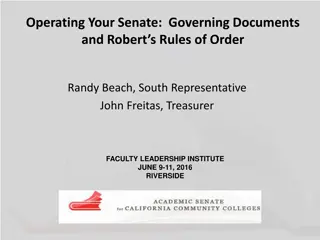

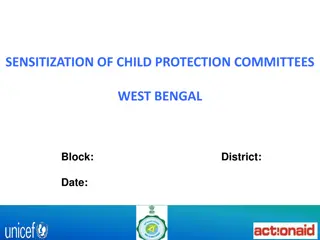
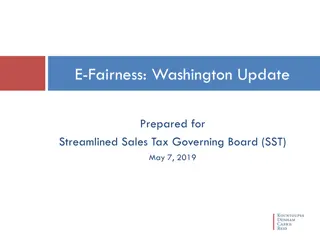






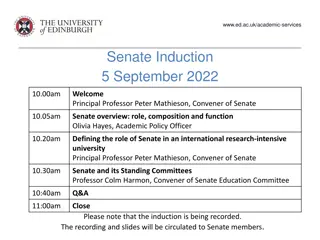

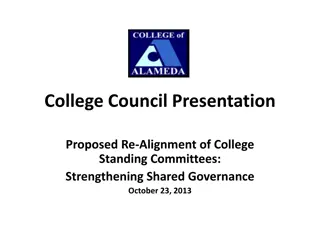


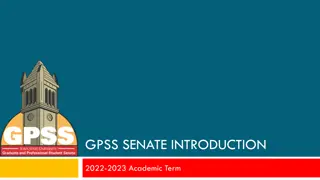
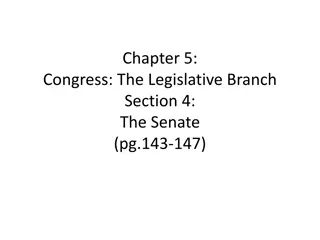
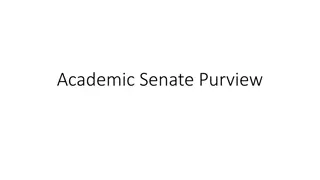

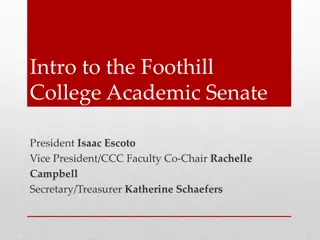
![Overview of the Faculty Senate at [Institution Name]](/thumb/233771/overview-of-the-faculty-senate-at-institution-name.jpg)